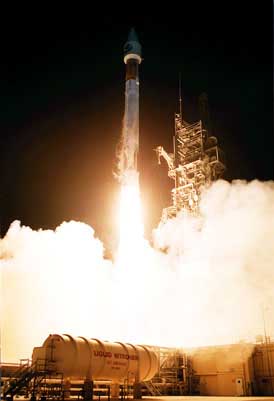GOES-L
The Geostationary Operational Environmental Satellite (GOES)-L spacecraft
was carried in space aboard a Lockheed Martin Atlas IIA rocket. Twenty-seven
minutes later, the spacecraft separated from the Centaur stage. At approximately
4:22 a.m., controllers successfully deployed the outer panel of the solar
array, making the spacecraft power positive and allowing the batteries
to charge.

The spacecraft is a three-axis internally stabilized weather spacecraft
that has the dual capability of providing pictures while performing atmospheric
sounding at the same time. Once in orbit the spacecraft is to be designated
GOES-11 and will complete its 90 day checkout in time for availability
during the 2000 hurricane season.
Throughout the next 17 days, NASA and the National Oceanic and Atmospheric
Administration (NOAA) controllers are scheduled to perform several apogee
motor firings and adjust maneuvers, culminating with the spacecraft arriving
in a geosynchronous orbit 22,240 miles (35,788 kilometers) above the Earth's
equator at 104 degrees West Longitude. Controllers will operate the spacecraft
from the NOAA Satellite Operations Control Center in Suitland, Md.The first
of several burns to move the spacecraft into its final orbit begin approximately
20 hours after liftoff, when controllers perform the first apogee motor
firing, lasting for 53 minutes.
